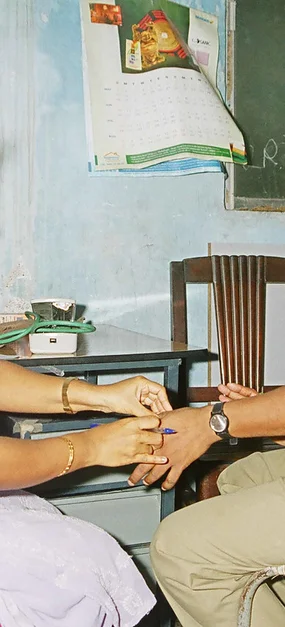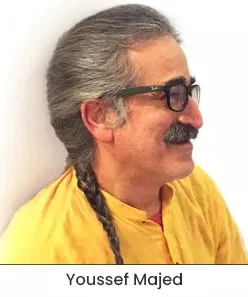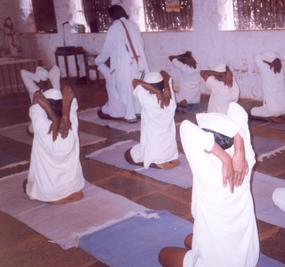How two women are changing the lives of prison inmates
“This is the best thing I’ve received so far,” a juvenile inmate from San Jose’s Juvenile Detention Center smiled as she received a certificate for completing IAHV’s Prison Program.“I want to be more patient. With the techniques I have learned in this program, I think it is possible,” she adds.
Another juvenile shared, “I feel like I have been released.”
Aparna Atmaram grins like a proud parent. She has been facilitating prison programs at the detention center for over a year now. “The amount of trauma they’ve been through is enormous. So much that even closing their eyes during the program is extremely difficult. It is wonderful to see them transform in a few days, to see them smile from their heart and turn hopeful,” says Aparna.
As a working mom and engineer by profession, Aparna’s life has become intertwined with the detention center where she is a regular visitor and program facilitator. “I see them as my own kids,” she quips.
Over two thousand miles away from Aparna, Paola Gutt is leaving her Miami home to pick her girls from school. Like most days, this day has been a busy one. As a faculty with The Art of Living, she organizes and teaches Happiness programs in her city. As a mother, preparing lunch for her daughters, sending them to school, picking them up, and spending quality time with them adds to her daily list.
Though that is not all.
Within an hour of dropping her daughters home, she will be hitting the road again. This time to the Homestead Correctional Institute, an hour ride from home – a prison where she has been conducting prison programs for the past five years.
She explains why she goes there. “These are women who have lost hope and are trying to forgive themselves. The hope and emotional relief they find in these techniques and the program is palpable. So much so that they wait for the follow-up every week like it is the last day of their lives. You cannot fail these women. You have to be there. Every week,” says Paola.
Strong beginnings
“I already know how to breathe. I don’t need a class for that.”
As a breathwork facilitator, these are not the words you anticipate on the first day of class. However, Aparna didn’t mind as she began her journey of healing troubled teens. “The next day, this teen told me that she could walk away from an argument which could land her in detention because she remembered to use the victory breath (that she learned on the first day of the program),” reminisces Aparna.
Perhaps, Aparna’s experience in teaching at-risk high school teens in East San Jose and Chicago equipped her to face challenges of teaching at the Juvenile Detention Center.
“When we started the pilot program, initially inmates and the staff would laugh as we taught the breathing techniques. It was unfamiliar and looked funny. They had no reason to believe that something as simple as breath could be so powerful,” says Aparna.
Yet their response changed after a few sessions. The teens, who told her they hated the kriya on the first day, started encouraging others to practice it at the end of the program. After a few days, the inmates and prison staff shared how the techniques helped them stay calm during the day.
After the first pilot program, Aparna continued to take programs at the detention center. “There is not a single class where I don’t mention the story of the student who didn’t need a lesson on how to breathe,” winks Aparna.
A few miles away and a few years ago, Paola began her journey with prisons during her college days in Colombia. “My experience in assisting and teaching IAHV’s prison programs in US prisons was starkly different from my volunteering days in college. The IAHV program and techniques give real results to inmates.”
Paola has witnessed umpteen instances of the prison program helping inmates. Once a program participant got in trouble with the prison staff. “She said that she started breathing the way she learned in the program. That made her calm when all she wanted to do was hit the policeman. It eventually saved her from solitary confinement,” recounts Paola.
Gaining trust
Despite the benefits, inmates do not instantly take to the idea of sitting with eyes closed and breathing in a particular rhythm or even doing yogic exercises.
“I get a lot of tantrums and complaints from the teens. Many try to disrupt the program,” tells Aparna. Paola has similar experiences. “They may ignore you, walk away on day one or even laugh at you,” says Paola.
Paola attributes the resistance to the pent-up frustration, emotional pain, and regrets in women inmates. Aparna suggests the kids are processing transgenerational trauma during the program.
So, how do the two bring inmates to participate?
“I stay honest. I share my own apprehensions of coming here and their reactions,” says Paola. “When I open up, they gradually begin to trust me and the processes.”
However, it is still hard for some inmates. “I respond to difficult situations by staying centered, calm and compassionate. I continue teaching no matter what goes on,” says Paola. “Many eventually come around.”
For Aparna, feeling at home does the magic. “Everything flows after that. All pre-program apprehensions melt away. Then, it’s easy to be myself and I am able to see them as my own,” she says. “My meditation practice helps me a great deal to stay grounded and connected. When I get nervous, breath helps me come back to the moment. Whenever I sense they are losing interest, I let my intuition guide the program.”
Prison staff of both prisons have reported improved behaviors, emotional and mental states of inmates.
- Women inmates are less lethargic and more able to carry out their daily duties.
- Improved behavior immediately reduces their time in prison.
- Juveniles are inspired to change their lives by having a say over their mind.
- Many share they plan to use these techniques to stay calm during court hearings.
Aparna has also realized that negative responses are not always what they look like. “When they ask questions to derail, I know they are just seeking attention. I take that as a sign of wanting to connect. When they try to disrupt the program, I understand that they are stepping out of their comfort zone, which is huge as they are in the process of rewiring their relationship with their patterns,” shares Aparna.
A journey of transformation
A few years ago, when Paola began assisting programs for women inmates at Florida’s prison, a thought struck her: “How did these women, who look just like me, end up here?”
Over time, she realized the only difference between them and her was that she had the support of friends and family in her moments of despair and frustration. While those inmates did not. “You naturally become more compassionate and forgiving with this understanding. I think you cannot but grow as a better human being after teaching in prisons,” Paola says.
Aparna has found change by becoming more accepting of herself and others. “When I started my journey, there was a lot of restlessness about wanting to fix the system and the kids. But, now I understand what infinite patience and acceptance look like. This acceptance is my biggest strength. It gives me the conviction and courage to stand there, to ask more from them, and allow the program to unfold as it gets them in touch with their inner selves. Somewhere in the journey of accepting those in front of me, I have begun to accept myself more. ”




















